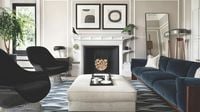As the housing market continues to shift, homeowners are increasingly opting to stay put and invest in renovations rather than risk entering the competitive buying landscape. A recent report by Houzz highlights emerging trends in home renovations for 2025, revealing that while the market remains a seller's haven, many are taking the opportunity to enhance their current homes. Marine Sargsyan, a staff economist at Houzz, sheds light on the motivations behind these renovation trends and the changing preferences among homeowners.
According to the Houzz report, released on April 30, 2025, renovating was tied with decorating as the two most popular activities among homeowners in 2024, with 54% of respondents engaging in each. Additionally, 47% reported having repaired their homes, while only 4% built a new home. As we move into 2025, the focus appears to be shifting slightly; 52% of homeowners are planning renovation projects, while only 35% intend to invest in new decoration projects. The inclination to renovate is accompanied by a decrease in interest in building new homes, with only 2% planning to do so in the coming year.
When it comes to the reasons behind this uptick in renovation projects, the Houzz survey revealed that a significant 40% of respondents feel they finally have the time to undertake such projects. In addition, 35% noted they now possess the financial resources necessary for renovations. Other motivations include customizing recently purchased homes (21%), addressing damage due to age or other factors (17%), and adapting to lifestyle changes (another 17%). Interestingly, only 7% plan to renovate in anticipation of selling their homes soon, while another 7% are addressing damage from natural disasters.
As homeowners look to enhance their spaces, bathroom renovations are gaining traction. Traditionally, kitchens have been the most popular area for renovations, but the Houzz report reveals that guest bathrooms are now tied with kitchens, with 24% of respondents indicating they are renovating both spaces. Furthermore, 22% are remodeling their primary bathrooms, while 18% are renovating living rooms, and 14% are updating guest bedrooms. Other areas seeing renovations include closets, laundry rooms, and primary bedrooms, each at 13%.
In terms of budgeting, midrange projects, costing between $10,000 to $49,000, comprised the largest share of renovation expenditures in 2024, accounting for 43% of all projects. Specifically, 25% of homeowners spent between $10,000 and $24,999, while 18% invested between $25,000 and $49,000. On the higher end, 16% of respondents reported spending over $100,000 on their renovations.
Funding these renovation projects is a crucial consideration for homeowners. The Houzz report indicates that 84% of respondents dip into their savings for renovations, while 29% use credit cards, and 12% rely on secured home loans. Among these, home equity lines of credit (HELOCs) are the most popular option, chosen by 6% of homeowners. Other financing methods include cash from home sales (10%), gifts and inheritances (5%), insurance payouts (5%), tax refunds (4%), unsecured loans (3%), and retirement plans (2%).
As homeowners embrace these renovation trends, the interior design landscape is also evolving. On May 1, 2025, Homes and Gardens published an article detailing the trends that interior designers are growing tired of seeing in 2025. Designers expressed their frustrations with certain recurring styles, including shiplap, fast furniture, and overly minimalist designs.
Shiplap, once a darling of home design, is now viewed as overplayed. Yena Jung of By Yena Designs stated, "There are so many places I see shiplap being used, and it's just so overplayed. I especially do not want a feature wall to be made with shiplap." Instead, she advocates for geometric patterns or textured paints as more interesting alternatives.
Fast furniture, characterized by its rapid production and often low quality, is another trend that designers are keen to move past. Kathy Kuo, founder of Kathy Kuo Home, remarked, "The trend towards turning to 'fast furniture' to impulsively replicate every viral look is one I don't love. My personal ethos is all about choosing timeless, well-made, and sustainable furniture and decor pieces."
Additionally, designers are expressing fatigue with the minimalist aesthetic, particularly with white bouclé fabric, which Eliza McNabb criticizes for its lack of sustainability. She noted, "While we love nubby texture, this fabric has become ubiquitous and, unfortunately, doesn't always hold up to wear and tear."
Beyond these specific materials, designers are also wary of cramped 'micro' spaces that prioritize style over function. Vyanca Soto, principal designer at Market Studio Interiors, stated, "I'm ready to move past the hyper-trendy 'micro spaces' packed with tiny furniture and oversized decor meant for social media moments rather than real living."
As the design landscape shifts, homeowners are increasingly looking for authenticity and character in their spaces. This growing desire for unique and personal touches aligns with the trend of investing in renovations rather than moving, as homeowners seek to create environments that reflect their individuality and lifestyle.
In a world where design trends come and go, the current focus on renovation, sustainability, and personal expression seems to be here to stay. Homeowners are not only enhancing their living spaces but are also shaping the future of interior design through their choices and preferences.


